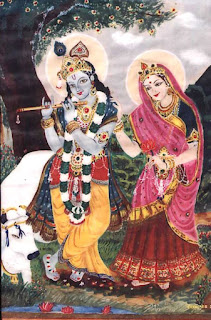We celebrate our birthday on the birth star falling in the solar month.
(Refer How to celebrate birthday. )
Birthdays of Gods are a different genre.

They are celebrated on the thithis in the respective lunar months.
Rama's birth day is not celebrated on his birth star, Punarvasu but on the thithi he was born. Let us see why.
A Thithi is different from a star.
When we speak about star, we actually refer to 1/ 27th portion of the circle of 360 degrees of the zodiac. This is equal to 13-20 degrees. Starting from zero degrees Aries, the sky (Zodiac) is divided into 27 equal parts and each part is known by a star present in that part.
Thithi is the distance between the Moon and the sun. The starting point is not Aries. The starting point is the conjunction of the moon and the sun (Amavsaya).
The distance from one conjunction to another is a circle which means 360 degrees. This distance is covered in 30 days. So in one day 12 degrees are covered. A Thithi thus has 12 degrees whereas the star has 13-20 degrees. The conjunction of a star and a particular Thithi will not be repeated every year.
For ordinary mortals like us, the birth star (birth star is the star in which moon transits on the day of birth) determines our thoughts, attitudes and life events.
For Gods, there is no such thing that a star can do to them!!.
Their birthdays are times for doing austerities and spiritual practices.
Thithi is best suited for such austerities.
The distance between the sun and the moon determines the time that will be helpful to do spiritual sadhana. The important thithis in this regard are the 4th (Chathurthi), 6th (Sashti), 8th (Ashtami), 9th (Navami), 11th (Ekadasi) and 14th (Chathurdasi).
On these thithis, gods namely Ganesha, Subrahmaya, Krishna, Rama, Vishnu and Rudra (respectively) are meditated upon. Meditation on these Gods on these respective thithis give desired results for a spiritual practitioner.
I am tempted to say that it is divine design that these Gods were born or associated with these thithis, so that mankind can extract maximum benefits from the respective spiritual practices by remembering respective gods on these days.
Per this, the birth of Rama or Krishna on the respective thithis is not a coincidence. It is divine Will.
Looking at the sky on these thithis, some special significances can be noticed.
 Particularly Astami and Navami come with the sun and the moon at right angles to the earth.
Particularly Astami and Navami come with the sun and the moon at right angles to the earth.
The result is that the combined pull of the sun and the moon on these thithis is lowest on the earth on ashtami and navami. The combined Luni- solar effect on tides and water bodies is a well known scientific fact. Our body also contains lot of fluids that control our thoughts, works and the internal organ systems. The Luni-Solar pull affects these fluids too. But on the 8th and 9th thithis, the Luni- solar effect will be minimal on all water bodies including our body. Meditation or thought forces done on these thithis can sink deeper in us – in the absence of any disturbance from the Luni- Solar pull. It is perhaps to tap this advantage, Gods themselves decided to be born on these thithis!!
An interesting astrological feature about these thithis is that baring the 11th Thithi, all the others are what we call “Paksha Chidras” – or ‘weaknesses or holes in the fortnightly sojourn of the Moon’.
Instead of Ekadasi, Dwadasi is part of this group.
While the moon is moving in these thithis, it experiences some jerks. One can judge this by looking at the distances between the Sun and the moon.

Between Dwadasi and sashti (of any fortnight – waxing or waning) the moon comes within the strong grip of the Sun. Almost all the earthquakes of intensity that causes damage to the upper crust occurs when moon passes these thithis.
Our sojourn in the sky on these thithis seems to be in need of some divine protection. It is as though by the blessings on Lord Ganesha, we cross the Chathurthi, with the blessings of Lord Subrahmanya, we cross Sashti and with the blessings of Lord Shiva, we cross Chathurdasi. Every fortnight we remember these thithis and pray respective Gods.
 Ashtami and Navami are completely away from this group.
Ashtami and Navami are completely away from this group.
They come with least Luni-solar effect. They are spiritual as well as celebration times.
Gokulaashtami and Rama Navami are both celebration times and times for Spiritual thoughts.
The effectiveness of these thithis in spiritual sadhana is the reason for celebrating the birthdays of Gods on thithis.

















